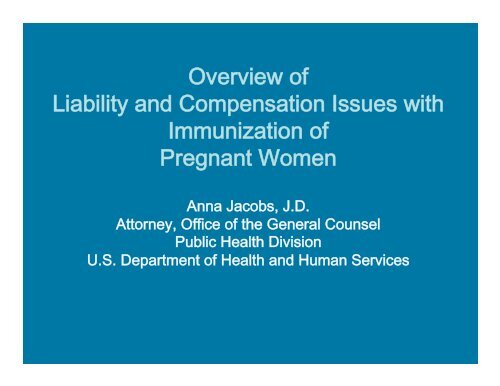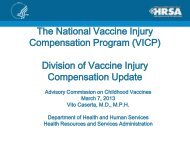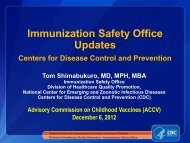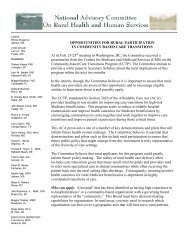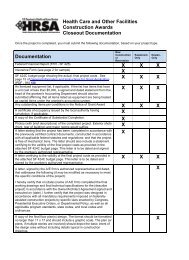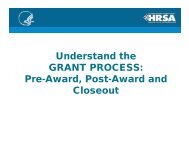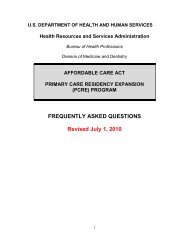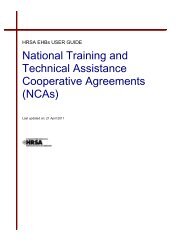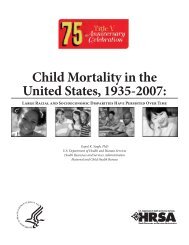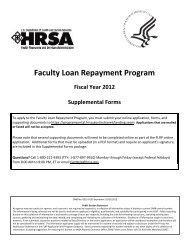Overview of Liability & Compensation Issues with ... - HRSA
Overview of Liability & Compensation Issues with ... - HRSA
Overview of Liability & Compensation Issues with ... - HRSA
Create successful ePaper yourself
Turn your PDF publications into a flip-book with our unique Google optimized e-Paper software.
<strong>Overview</strong> <strong>of</strong> <br />
<strong>Liability</strong> and <strong>Compensation</strong> <strong>Issues</strong> <strong>with</strong><br />
Immunization <strong>of</strong> <br />
Pregnant Women<br />
Anna Jacobs, J.D.<br />
Attorney, Office <strong>of</strong> the General Counsel<br />
Public Health Division<br />
U.S. Department <strong>of</strong> Health and Human Services
Outline<br />
I. Relevant statutory provisions<br />
II. Maternal Immunization and VICP<br />
Case Law<br />
III. HHS interest in maternal immunization
Process<br />
• Eligible individual must first file claim in the<br />
VICP against Secretary <strong>of</strong> Health and<br />
Human Services.<br />
• Must prove:<br />
– Eligibility to file.<br />
– Sustained injury listed on Vaccine Injury Table<br />
(causation presumed) or <strong>of</strong>f-Table (must prove<br />
causation).
Post-VICP<br />
• Petitioner must accept or reject judgment.<br />
• If accept, then matter is final.<br />
• If reject, then can sue manufacturer or<br />
administrator in civil court (limitations).
Not Eligible?<br />
• Not required to file in the VICP. May bring<br />
civil suit directly.<br />
• If file in VICP and found ineligible, case is<br />
dismissed.
Maternal Immunization <br />
in the VICP<br />
• Claims for mother’s own injuries.<br />
• Claims for injuries to fetus (and miscarriage).
Relevant Statutory Language<br />
• Petitioner must prove “that the person who<br />
suffered such injury or who died…received a<br />
vaccine set forth in the Vaccine Injury Table or<br />
if such person did not receive such a vaccine,<br />
contracted polio, directly or indirectly, from<br />
another person who received an oral polio<br />
vaccine” 42 U.S.C. 300aa-11(c)(1)<br />
• “Only one petition may be filed <strong>with</strong> respect to<br />
each administration <strong>of</strong> a vaccine.” 42 U.S.C.<br />
300aa-11(b)(2)
VICP Cases<br />
• VICP parties have not agreed on the meaning <strong>of</strong> these<br />
provisions.<br />
• Special Masters and judges have not come to a consensus.<br />
– Some say can bring in utero claim.<br />
• Interpret “received” broadly to match remedial nature <strong>of</strong> the<br />
statute.<br />
– Some say cannot bring in utero claim.<br />
• Interpret “received” narrowly. Expression <strong>of</strong> one indirect method<br />
(oral polio exception) is the exclusion <strong>of</strong> all other indirect<br />
methods (in utero receipt).<br />
• One petition rule not widely addressed by special masters.<br />
• No cases have reached the Federal Circuit. No binding<br />
precedent. Not settled one way or the other.
<strong>Issues</strong> <strong>with</strong> Coverage <strong>of</strong> Vaccines<br />
• Vaccines under development (RSV, GBS),<br />
if approved, may only be exclusively<br />
recommended for pregnant women.<br />
• Statute limits covered vaccines to<br />
vaccines that are “recommended for<br />
routine administration in children.”<br />
• How can these vaccines attain coverage?
HHS Interest in Maternal<br />
Immunization<br />
• Influenza, Tdap<br />
• Healthy people 2020 Goals<br />
• Countermeasures Injury <strong>Compensation</strong><br />
Program (CICP)<br />
• NVAC, ACCV
CICP<br />
• Provides compensation for injuries and deaths directly caused by the<br />
administration or use <strong>of</strong> “covered countermeasures” used in public health<br />
emergencies.<br />
• <strong>HRSA</strong> exercised its broad authority under the Public Readiness and<br />
Preparedness Act to promulgate regulations to implement the CICP.<br />
• Issued regulation that specifies a child can qualify as an injured<br />
countermeasure recipient if the child survives birth, and is born <strong>with</strong>, or later<br />
sustains, a covered injury as the direct result <strong>of</strong> the mother’s administration<br />
or use <strong>of</strong> a covered countermeasure during pregnancy. See 42 C.F.R.<br />
110.3(n), and preamble discussion at 75 FR 63660.<br />
• Note differences between CICP and VICP. CICP statute gives broad<br />
authority to promulgate regulations to administer the program. VICP statute<br />
has specific authority to revise the Table and determine cost <strong>of</strong> health<br />
insurance. VICP only covers vaccines. CICP covers countermeasures other<br />
than vaccines, such as antiviral that can be inhaled or ingested. The CICP<br />
regulation on countermeasure recipient is in reference to a variety <strong>of</strong><br />
countermeasure products. VICP statute is in reference to vaccines.
Thank You.


